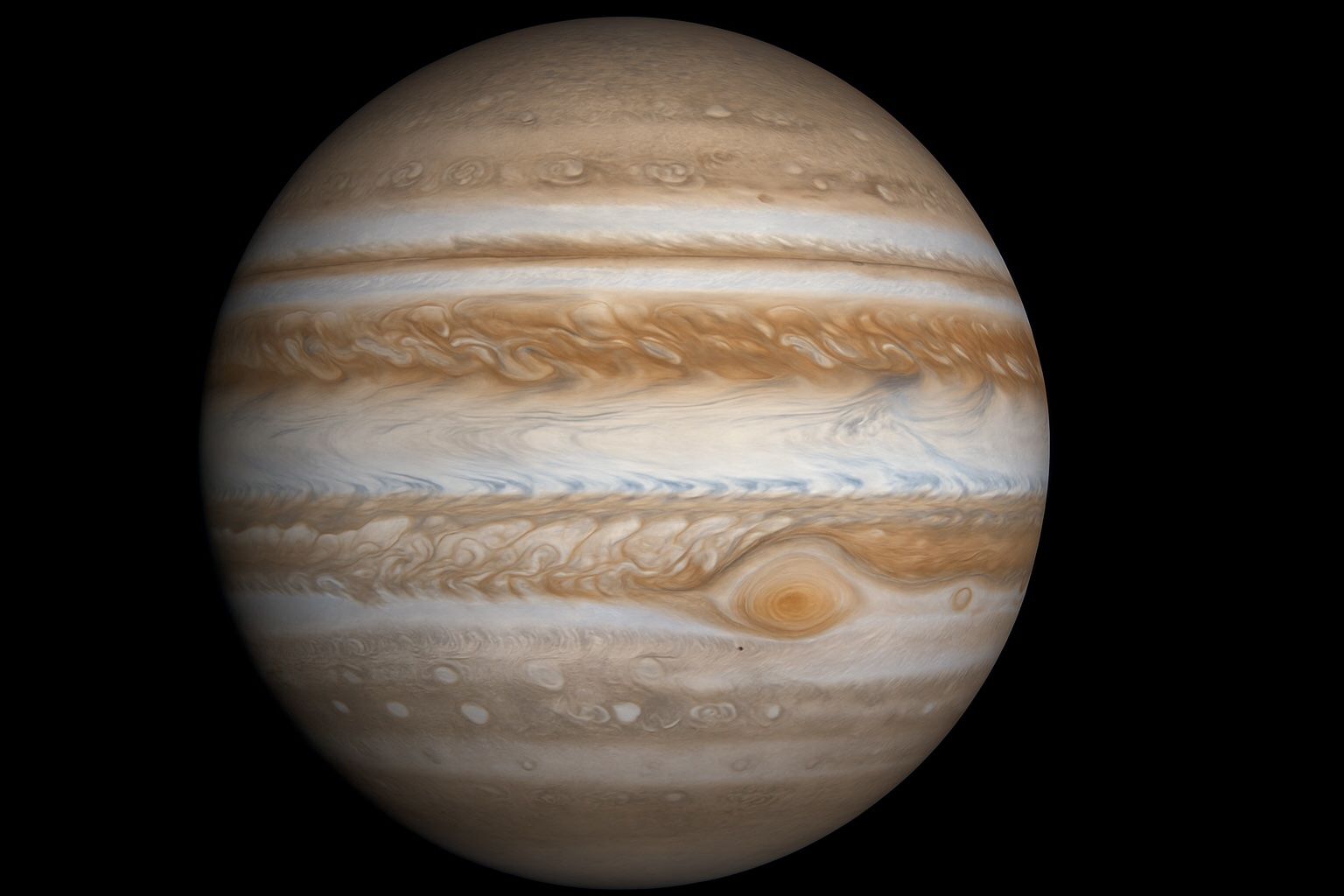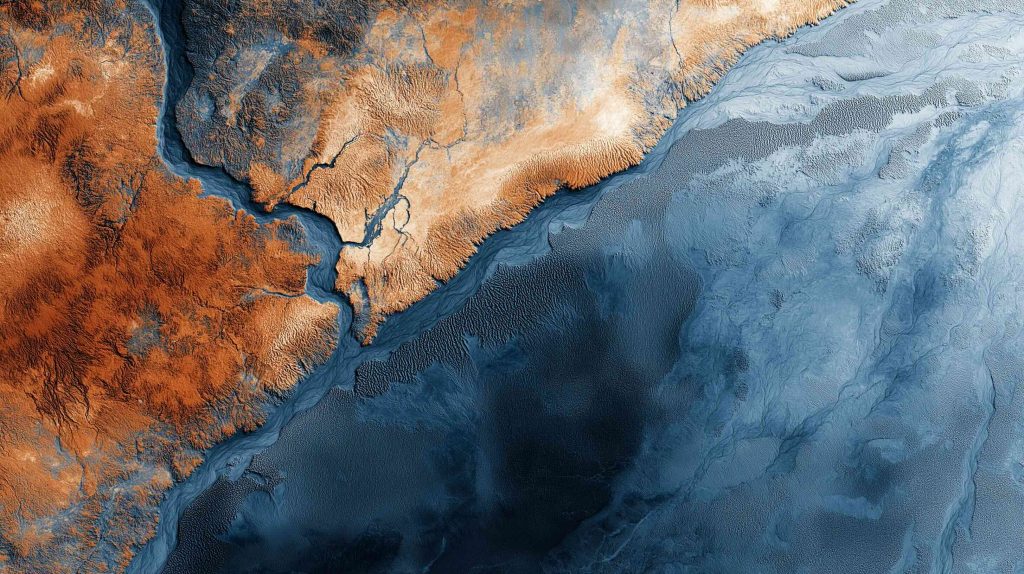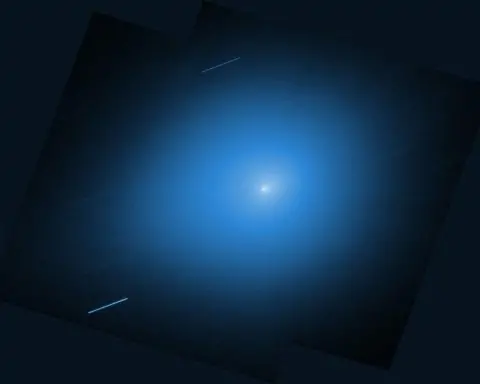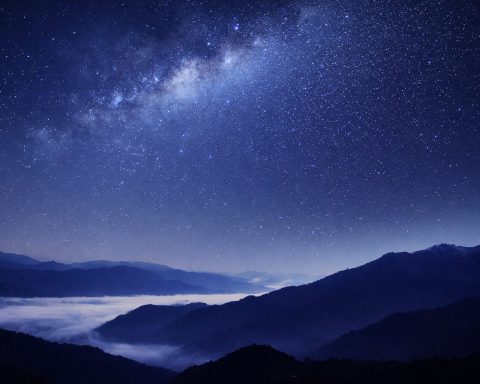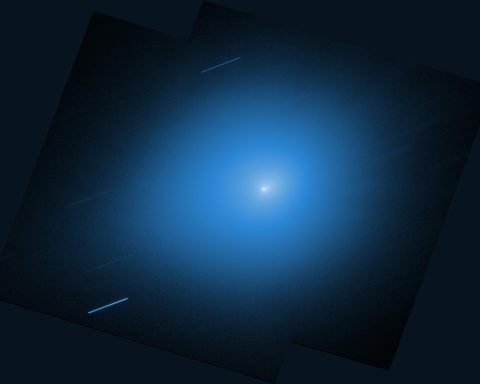- Jupiter is the Solar System’s largest planet, about 318 Earth masses, with a rotation period of roughly 9.9 hours per day.
- It is composed mainly of hydrogen and helium, with a metallic hydrogen layer that powers a strong magnetic field via a dynamo.
- The Great Red Spot is a storm at least 300–350 years old, about twice Earth’s diameter, whose roots extend roughly 300 miles (500 km) into the atmosphere.
- Jupiter’s magnetosphere extends 1–3 million kilometers toward the Sun and a tail over 600 million kilometers long, with a field 14–54 times stronger than Earth’s and new radiation zones near the cloud tops.
- The planet has a faint ring system first imaged by Voyager 1 in 1979, composed of fine dust replenished by meteoroid impacts on its inner moons.
- There are at least 95 confirmed moons around Jupiter as of 2025, including the Galilean moons Io, Europa, Ganymede, and Callisto discovered by Galileo in 1610; future missions Europa Clipper (arriving 2030) and JUICE (arriving 2031) are planned to study them.
- Io is the most volcanically active body in the solar system, with hundreds of active volcanoes and plumes, observed by Voyager 1 in 1979 and by Juno at about 1,500 km altitude in December 2023.
- Europa likely hosts a global ocean 60–150 km deep beneath a 15–25 km thick ice shell, with possible water vapor plumes detected by Hubble and the Europa Clipper arriving in 2030 to investigate habitability.
- Ganymede, 5,268 km in diameter, is the largest moon in the solar system and the only moon known to generate its own magnetic field, with a deep salty ocean likely beneath layered ice.
- Callisto, the outer Galilean moon with a heavily cratered surface (diameter ~4,820 km), may harbor a salty subsurface ocean 100–150 km below its surface.
Jupiter: The Solar System’s Giant Planet
Jupiter’s turbulent atmosphere, as captured by NASA’s Juno spacecraft in 2019, showcases its reddish-brown cloud bands and the iconic Great Red Spot (lower right) [1] [2].
A Planet of Superlatives: Jupiter is the largest planet in our solar system – so big that if it were a hollow shell, over 1,000 Earths could fit inside [3]. It contains more than twice the mass of all other planets combined [4], essentially gobbling up most of the material left over after the Sun’s formation. Despite its huge mass (about 318 Earth masses) and volume, Jupiter rotates astonishingly fast: one day lasts only ~9.9 hours on Jupiter, giving it the shortest day of any planet [5]. This rapid spin flattens Jupiter slightly at the poles and drives powerful winds in its atmosphere.
Composition and Structure: Often called a “failed star,” Jupiter is composed mostly of hydrogen and helium – the same light elements that make up the Sun [6] [7]. In fact, Jupiter has the right ingredients for a star but never grew massive enough to ignite fusion. As we descend under its cloud tops, the pressure skyrockets: hydrogen gas is compressed first into a liquid, and then into an exotic liquid metallic hydrogen state that conducts electricity [8]. This metallic hydrogen, combined with Jupiter’s swift rotation, generates a mighty magnetic field via a dynamo effect [9] [10]. Deep in the center lies a mysterious core. Recent data from NASA’s Juno orbiter suggest Jupiter’s core is not a compact ball of rock as once thought, but rather a “fuzzy” diluted core that may have been disrupted by a colossal impact or mixing processes [11] [12].
Atmosphere and Weather: Jupiter’s outer appearance is a mesmerizing tapestry of banded clouds and spots. The planet’s atmosphere forms colorful stripes – dark belts and bright zones – due to east-west jet streams roaring beneath the cloud tops [13]. Each band is a stream of ammonia, ammonium hydrosulfide, and water clouds at different altitudes, stretched into bands by Jupiter’s rotation [14]. Between and within these bands swirl gigantic storms. The most famous is the Great Red Spot, a cyclone-like storm twice as wide as Earth that has raged for at least 300-350 years [15] [16]. Recent observations show the Great Red Spot has been slowly shrinking in area in modern times [17], but it remains an awe-inspiring feature. Juno probe measurements revealed that this storm’s roots plunge about 300 miles (500 km) into Jupiter’s atmosphere [18] – 50 to 100 times deeper than Earth’s oceans, as one scientist noted [19]. Indeed, “one of the most basic questions about Jupiter’s Great Red Spot is: how deep are the roots?” said Dr. Scott Bolton, Juno’s Principal Investigator, and Juno has finally provided an answer [20]. Jupiter’s atmosphere is dynamic and turbulent: dozens of smaller storms dot the poles and mid-latitudes, and cloud bands can spawn oval storms that persist for years. With no solid ground underneath, storms can sustain themselves far longer than terrestrial hurricanes [21]. Wind speeds in Jupiter’s equatorial jets reach 335+ mph (539 km/h), driving whirling vortices and chaotic cloud swirls [22].
Magnetosphere and Radiation: Jupiter boasts an enormous magnetosphere – the region of space dominated by its magnetic field – that dwarfs even the Sun’s influence at Jupiter’s distance. The Jovian magnetosphere balloons 1–3 million kilometers toward the Sun and stretches into a tail more than 600 million kilometers long, reaching past Saturn’s orbit [23]. Jupiter’s magnetic field is 14 to 54 times stronger than Earth’s [24], and it traps swarms of charged particles in intense radiation belts encircling the planet. The environment close to Jupiter is extremely hazardous: high-energy particles whiz around, delivering radiation doses that could fry unshielded spacecraft electronics (or living cells) in minutes. In fact, Juno discovered a new radiation zone just above Jupiter’s cloud tops, full of high-speed hydrogen, oxygen, and sulfur ions [25]. “The closer you get to Jupiter, the weirder it gets,” quipped Dr. Heidi Becker, Juno’s radiation lead at JPL, on finding these surprise radiation zones [26]. Jupiter’s magnetic field also powers brilliant auroras at its poles – the brightest in the solar system – caused by charged particles slamming into its upper atmosphere.
Thin Rings: One of Jupiter’s surprising secrets is that it has a ring system – albeit a faint one. Unlike Saturn’s prominent icy rings, Jupiter’s rings are thin and dark; they were first discovered in 1979 when Voyager 1 photographed a gossamer ring encircling the planet [27]. These rings are composed of fine dust grains rather than bright ice [28]. Scientists determined that meteoroid impacts on Jupiter’s small inner moons continually kick up dust, which then spreads into ring arcs around the planet [29]. Thus, Jupiter’s rings are constantly replenished by its moonlets. They are only visible when backlit by the Sun, making them a hidden feature of this giant world.
From Telescopes to Spacecraft: A History of Jupiter Exploration
Humans have been gazing at Jupiter since antiquity – the bright “wandering star” that outshines almost everything else in the night sky. It wasn’t until Galileo Galilei turned his telescope to Jupiter in 1610 that we truly began to uncover Jupiter’s secrets. Galileo observed four star-like points moving around Jupiter – the first moons discovered around another planet [30]. This groundbreaking observation (of Io, Europa, Ganymede, and Callisto) proved not everything revolves around Earth, a key moment in the history of astronomy. Fast-forward over 400 years, and we have sent numerous robotic explorers to Jupiter. Below is a timeline of major Jupiter exploration milestones:
- Pioneer 10 (1973): Pioneer 10 was the first spacecraft to visit Jupiter, launching in 1972 and flying past Jupiter in December 1973 [31]. It sent back the first close-up images of Jupiter, its cloud belts, and moons, opening the era of robotic exploration of the outer planets. After its Jupiter flyby, Pioneer 10 continued on toward the edges of the Solar System [32]. Its sister craft Pioneer 11 followed with a Jupiter flyby in 1974, coming even closer before heading to Saturn [33]. Both Pioneers carried golden plaques in case they are ever found by extraterrestrials.
- Voyager 1 and 2 (1979): NASA’s twin Voyager probes revolutionized our understanding of Jupiter. Voyager 1 flew by in March 1979, discovering Jupiter’s thin ring and two new small moons, and famously catching active volcanoes erupting on Io – the first known volcanoes beyond Earth [34]. This was an astonishing find, revealing Io’s extreme volcanism. Voyager 2 arrived a few months later (July 1979), imaging Jupiter’s swirling clouds and making close passes of the major moons [35]. Voyager 2’s observations of Europa’s cracked ice crust hinted at a subsurface ocean, sparking decades of speculation. Together, the Voyagers returned stunning photos – from Jupiter’s Great Red Spot to the battered surface of Callisto – and took a grand tour onward to Saturn and beyond.
- Galileo Orbiter (1995–2003): Galileo was the first spacecraft to orbit Jupiter, transforming it from a brief visitor to a long-term resident. Launched by Space Shuttle Atlantis in 1989, Galileo arrived at Jupiter in December 1995 and released a probe that plunged into Jupiter’s atmosphere – the first (and so far only) in situ measurement of a giant planet’s atmosphere [36]. The orbiter then spent 8 years orbiting Jupiter, conducting dozens of flybys of the Galilean moons. Galileo gave us close-ups of Io’s lava lakes, Europa’s icy cracks, Ganymede’s grooved terrain, and Callisto’s craters. Importantly, Galileo found evidence of saltwater oceans inside Europa, Ganymede, and even Callisto, completely changing our view of these moons as potential habitats for life [37] [38]. After a highly successful mission, Galileo was deliberately directed to crash into Jupiter in 2003 to avoid any chance of contaminating Europa’s ocean with Earth microbes [39] [40].
- Cassini and New Horizons Flybys: Other spacecraft en route to the outer solar system have used Jupiter’s gravity as a slingshot and taken the opportunity to make observations. NASA’s Cassini spacecraft, on its way to Saturn, flew by Jupiter in late 2000. For about 6 months, Cassini observed the Jupiter system, snapping 26,000 images and creating one of the most detailed global color portraits of Jupiter [41] [42]. It captured features like shifting cloud patterns and volcanic eruptions on Io. In 2007, NASA’s New Horizons (bound for Pluto) also flew past Jupiter, taking valuable images of the Jovian moons and testing its instruments. New Horizons caught an erupting plume on Io and studied Jupiter’s magnetotail, adding to our knowledge before speeding along to Pluto.
- Juno (2016–Present): NASA’s Juno spacecraft entered Jupiter’s orbit on July 4, 2016, becoming the first orbiter since Galileo. Juno is in a unique polar orbit, diving in close to Jupiter’s cloud tops with each pass. Its mission: probe beneath the clouds and map Jupiter’s gravity, magnetic field, and atmospheric structure [43]. Juno has made groundbreaking discoveries – confirming the diffuse “fuzzy” core, mapping ammonia and water distribution, and peering into polar cyclone clusters. It also carries the JunoCam, which has provided breathtaking high-resolution images of Jupiter’s vortices and auroras. Initially slated for a few years, Juno’s mission has been extended through at least 2025 [44]. It will continue to study not just Jupiter but also conduct close flybys of moons (it skimmed Ganymede in 2021, and is currently performing a series of Io flybys in 2023-2024). Juno’s ongoing data collection is painting the most detailed picture yet of Jupiter’s inner workings.
- Europa Clipper (2024 – Future): In a sign of renewed interest in Jupiter’s moons, NASA launched the Europa Clipper mission on October 14, 2024 [45] [46]. This large spacecraft (destined to arrive at Jupiter in 2030) will focus on Europa, performing dozens of close flybys to investigate the thickness of its ice shell, the composition of its surface, signs of active geysers, and the habitability of its subsurface ocean [47]. Europa Clipper carries ice-penetrating radar, spectrometers, and cameras to “follow the water” and assess if Europa’s environment could support life. It’s the first mission dedicated to a Galilean moon since Galileo.
- JUICE (2023 – Future): The Jupiter Icy Moons Explorer (JUICE) is a European Space Agency mission launched in April 2023 [48]. JUICE will arrive at Jupiter in 2031 and spend at least three years studying three Galilean moons – Europa, Ganymede, and Callisto – in depth [49]. Notably, JUICE will actually enter orbit around Ganymede, becoming the first spacecraft to orbit a moon other than our own. Its suite of instruments will map Ganymede’s surface, probe its ocean, and measure Jupiter’s environment. NASA is contributing hardware to this international mission [50]. Together, Europa Clipper and JUICE herald a new era of Jovian exploration aimed at those intriguing ocean worlds.
Each mission has built on the discoveries of the previous ones, revealing Jupiter as a complex system more akin to a “mini solar system” than a solitary planet. And with new missions on the horizon, the exploration of Jupiter and its moons is far from over.
Jupiter’s Many Moons: A Mini Solar System in Its Own Right
Jupiter doesn’t travel alone around the Sun – it is trailed by an entourage of at least 95 known moons (as officially recognized by the International Astronomical Union) [51]. These moons range from big planet-like worlds to tiny asteroid-like rocks only a few kilometers across. In many ways, Jupiter’s massive moon system resembles a miniature solar system, with the four largest moons (the Galilean moons) behaving like planets orbiting their giant primary. In addition, Jupiter’s gravity has captured a swarm of smaller objects – so many that scientists suspect there are likely hundreds more tiny moons yet to be discovered, but only the larger ones are given names [52]. In fact, astronomers have detected “thousands of small objects” (down to meter-sized) orbiting Jupiter, embedded in its rings or distant reaches [53] [54]. The smallest of these will remain unnamed unless deemed scientifically interesting, per new IAU guidelines [55].
Moon Categories: Jupiter’s moons are generally divided into a few groups:
- Inner Small Moons: Very close to Jupiter (inside Io’s orbit) lie four tiny moons – Metis, Adrastea, Amalthea, and Thebe. These moons (each only tens of kilometers across, except ~250 km Amalthea) race around Jupiter in just 7 to 16 hours. They orbit within or near Jupiter’s faint rings, and serve as the source of the ring dust: meteoroid impacts on these moonlets knock dust into orbit, which replenishes Jupiter’s rings [56]. Amalthea, discovered in 1892, was the first moon found after the Galileans, while the others were discovered by the Voyager probes in 1979. These inner moons are irregularly shaped chunks of rock; they likely formed from Jupiter’s leftover disk or are captured fragments.
- The Galilean Moons: Moving outward, the next four moons are the Galilean satellites – Io, Europa, Ganymede, and Callisto – by far the largest and most significant of Jupiter’s moons. They were all discovered by Galileo in January 1610 (and independently by Simon Marius around the same time) using one of the first telescopes [57]. Galileo’s discovery was historic, and today these four moons remain some of the most fascinating objects in the solar system. They range in size from just smaller than Earth’s Moon (Europa) to larger than the planet Mercury (Ganymede). Each Galilean moon is a unique world with its own character, as we will explore in detail below. They orbit in nearly circular, equatorial orbits – suggesting they formed alongside Jupiter from its original disk of material.
- Outer Irregular Moons: Beyond the Galileans, Jupiter is surrounded by dozens of irregular moons that orbit much farther out (millions of kilometers away) in eccentric, inclined, and often retrograde orbits (meaning they go around Jupiter opposite to Jupiter’s rotation). These diminutive moons – most just 1–50 km across – are believed to be captured asteroids or remnants of collisions [58]. They tend to clump into several orbital groups, possibly the shards of larger parent bodies that broke apart. For example, the Himalia group consists of a few moons (~170 km Himalia being the biggest) that share similar orbits, while other groups (named after moons like Ananke, Carme, Pasiphae) contain retrograde moons likely formed by captured comets/asteroids that fragmented. Scientists have concluded that the larger distant moons may be intact captures, whereas the numerous tiny ones are fragments from massive collisions that occurred long ago [59]. Modern observations, especially by astronomer Scott S. Sheppard and colleagues, have steadily increased the moon count – with dozens of new Jovian moons discovered in the 21st century alone [60] [61].
In summary, Jupiter’s roster of moons ranges from four planet-like giants to a multitude of asteroid-like moonlets. Next, we focus on the big four Galilean moons, which are truly some of the most remarkable places in the solar system.
A family portrait of the Jovian system: the edge of Jupiter (left) with its Great Red Spot, and the four Galilean moons in order of increasing distance (top to bottom): Io, Europa, Ganymede, and Callisto [62] [63].
Io: The Volcanic Inferno
Close-up of Io captured by NASA’s Juno probe in 2023, showing its vivid sulfurous colors. Io’s surface is mottled with bright sulfur deposits and dark lava fields; many volcanic pits and mountains are visible on this tortured moon. [64] [65]
Io is a true hellscape of a moon – the most volcanically active world in the entire solar system [66]. Dozens of volcanoes on Io are continuously erupting; NASA scientists have counted hundreds of active volcanic centers on its surface [67]. Some of these eruptive plumes blast fountains of lava and sulfurous gas dozens of miles high into space [68], creating umbrella-shaped plumes that were famously photographed by Voyager. Io’s volcanism is so intense that it reshapes the moon’s surface in real time – the entire surface can be repaved with fresh lava in a matter of years or decades. Lakes of molten lava (rich in silicate rock) have been confirmed on Io, and the largest eruptions can be observed with large telescopes from Earth as bright hotspots on the moon [69].
What drives Io’s volcanism? Io is caught in a dramatic gravitational tug-of-war between Jupiter and its other big moons. It orbits extremely close to Jupiter (just 350,000 km from Jupiter, closer than our Moon is to Earth) and is in a resonance with Europa and Ganymede – for every orbit of Ganymede, Io completes exactly four orbits and Europa two. This gravitational dance means that Io’s orbit is slightly eccentric and its distance to Jupiter varies, causing Jupiter’s immense gravity to flex Io’s interior. The flexing generates enormous tidal heat inside Io, melting its interior. In effect, Jupiter’s gravity kneads Io like a ball of dough, driving a continuous cycle of volcanic activity. Io’s surface is coated in sulfur compounds, giving it a sulfur-yellow, orange, and black mottled appearance like a pizza. The volcanic eruptions spew sulfur dioxide gas that freezes and snows back down, forming a very thin atmosphere and yellowish frost on the ground.
Io is roughly the size of our Moon (about 3,640 km in diameter, slightly larger than Luna) [70], but there the similarity ends. Unlike our cratered, geologically dead Moon, Io has no impact craters – any meteoroid scars are promptly buried by fresh lava. Mountains on Io can tower 16 km high (some even taller than Everest) but are not due to plate tectonics; they’re uplifted blocks of crust over magma reservoirs. The continuous resurfacing means Io is geologically young all over.
Humanity’s first hint of Io’s true nature came when Voyager 1 flew by in 1979. A young engineer, Linda Morabito, noticed a strange plume extending from Io in a Voyager image – it turned out to be an active volcano erupting, the first ever seen beyond Earth [71]. This was one of Voyager’s most stunning discoveries. Later, the Galileo orbiter watched Io up close in the 1990s, observing glowing hot lava flows and curtains of fire at volcanoes like Pele and Loki. In recent years, Juno has provided new views – in December 2023, Juno skimmed just 1,500 km above Io’s surface, taking high-resolution photos of fresh lava fields and erupting volcanoes [72]. This ongoing monitoring shows that Io’s volcanoes are constantly active and even variable in intensity. For instance, the volcano Loki Patera periodically brightens as its lava lake overturns.
All this volcanic fury also has effects on Jupiter itself: Io’s eruptions eject vast amounts of ionized sulfur and oxygen that get swept up by Jupiter’s magnetic field, creating a dense plasma torus around Jupiter and fueling auroras on the planet. Io is linked to Jupiter by an electric current (the Io-Jupiter flux tube) due to this ionized gas – truly a cosmic electromagnetic connection. In short, Io is a world gripped by internal fires. It offers scientists a natural laboratory for volcanism on a planetary scale. As NASA succinctly put it, “Io is Jupiter’s third largest moon, and the most volcanically active world in our solar system.” [73] With Juno’s ongoing mission and future telescopic observations, we’ll keep watching Io’s fiery dance around its giant parent.
Europa: The Icy Ocean World
Europa has long been a source of fascination because beneath its icy exterior lies the potential for life. About the size of Earth’s Moon (Europa’s diameter is ~3,120 km, ~90% of our Moon’s) [74], Europa is the fourth-largest of Jupiter’s moons and orbits a little further out than Io [75]. At first glance, Europa’s surface looks like a cracked eggshell or a veinous marble – a bright whiteish ice crust crisscrossed by dark reddish-brown streaks. These streaks (called lineae) are essentially giant cracks in the ice that have been filled in by material from below. The relative lack of impact craters on Europa indicates the surface ice is continually renewed, erasing old craters. This evidence, along with a slight magnetic field disturbance measured by Galileo, led scientists to conclude that Europa likely harbors a global ocean of liquid water beneath its frozen crust [76].
Subsurface Ocean and Life Potential: Europa’s hidden ocean is perhaps its most astounding feature. Scientists estimate a saltwater ocean 60–150 km deep lies below an ice shell perhaps 15–25 km thick. That ocean could contain twice as much water as all of Earth’s oceans combined [77] – an enormous volume of habitable real estate (in principle). Importantly, Europa’s ocean is in contact with a rocky seafloor below, which could allow chemical interactions like hydrothermal vents providing energy and nutrients. Europa thus checks some key boxes for potential life: liquid water, essential chemical elements, and energy sources. As NASA notes, Europa “may be one of the most promising places in our solar system to find present-day environments suitable for life beyond Earth” [78]. The prospect of life – even if just microbial – in Europa’s dark ocean has driven much of the recent scientific interest.
Europa’s surface itself is composed mainly of water ice. The brownish-reddish streaks likely contain salts and sulfurous compounds that have been irradiated by Jupiter’s radiation. These may be chemicals from the ocean below, squeezed up through cracks and then altered by radiation – essentially a hint of the ocean’s composition. Some regions called “chaos terrain” show jumbled, tilted ice blocks, as if the ice crust partly melted and refroze, hinting at local upwellings of warmer water. Hubble Space Telescope observations have also provided tantalizing hints of water plumes occasionally erupting from Europa’s south polar region, similar to geysers on Saturn’s moon Enceladus. If those plumes are confirmed (scientists have observed transient spikes in hydrogen and oxygen that suggest water vapor [79]), it means Europa’s ocean sometimes punches through, offering a chance to sample the ocean indirectly by flying a spacecraft through the plume.
Exploration of Europa: Our knowledge of Europa leapt forward thanks to the Galileo orbiter in the 1990s, which conducted a dozen close flybys. Galileo’s magnetometer found that Europa likely has an induced magnetic field, consistent with a conducting salty ocean beneath the ice. Images showed the intricate network of cracks and smooth plains of young ice. However, Galileo’s instruments were limited. That is why NASA’s Europa Clipper mission is so eagerly awaited – it is specifically designed to answer the looming questions. Launched in 2024, Europa Clipper will arrive in 2030 and perform ~50 flybys of Europa, mapping its surface at high resolution, probing the ice thickness with radar, measuring the magnetic signals to confirm the ocean’s depth and salinity, and sniffing for chemicals in any plume it can find [80] [81]. The primary goal is to assess Europa’s habitability: “to determine whether there are places below Europa’s surface that could support life” [82]. In the meantime, the Hubble Space Telescope continues to observe Europa (it has detected persistent water vapor in Europa’s atmosphere on the trailing hemisphere [83]), and Juno has even made a distant flyby, capturing a beautiful image of Europa’s surface in 2022 [84].
Europa’s allure lies in that stark contrast: a frozen, airless surface bombarded by radiation, underlain by a deep, dark ocean that might – just might – host living organisms. As one NASA slogan put it, “Follow the water,” and Europa has plenty of it. The coming years could bring answers as to whether this icy moon truly has the right ingredients for life. Until then, Europa remains one of the most intriguing enigmas of the Jovian system.
Ganymede: The Giant with a Magnetic Field
Ganymede is not only Jupiter’s largest moon, but the largest moon in the entire solar system – bigger even than planet Mercury. With a diameter of about 5,268 km, Ganymede is a behemoth among moons [85]. In fact, if Ganymede orbited the Sun instead of Jupiter, it could be classified as a planet in its own right. But Ganymede holds a unique distinction: it is the only moon known to generate its own magnetic field [86] [87]. This intrinsic magnetosphere, discovered by Galileo’s instruments, causes phenomena like auroras shimmering in Ganymede’s thin atmosphere. It’s a trait usually seen only in planets (Earth, for example), not moons, and hints at a partially molten iron core inside Ganymede generating a dynamo effect [88] [89].
Internal Structure – “Club Sandwich” Oceans: Ganymede’s bulk composition is roughly equal parts rock and water ice. One of the most significant findings about Ganymede is the evidence for a large subsurface ocean of liquid water. Ganymede’s ocean is sandwiched between layers of ice – and might even consist of multiple ocean layers stacked with different phases of ice. A NASA-funded study in 2014 modeled Ganymede’s interior and suggested it could have a “club sandwich” of oceans and ice – alternating layers perhaps 25 km each – rather than a single ocean [90]. “Ganymede’s ocean might be organized like a Dagwood sandwich,” said Steve Vance of JPL, referring to the multi-tiered nature [91]. This work, backed by earlier Galileo data, indicates Ganymede’s ocean might be extremely deep (hundreds of kilometers) and contain salts, meaning it could potentially have a dense, salty layer at the bottom in contact with rock [92] [93]. Notably, Ganymede’s ocean may hold more water than all of Earth’s oceans combined [94]. The confirmation came when Galileo observed Ganymede’s magnetic field variations, consistent with a conductive saltwater ocean under the ice. This ocean, while likely sandwiched between high-pressure ice layers, still raises interest in Ganymede’s habitability (though the multiple ice layers could make water-rock interactions less likely at the base).
Above the ocean, Ganymede’s ice shell and surface are a mix of older dark regions and younger lighter terrains. Ganymede’s surface has two types of terrain: heavily cratered dark areas (older) and lighter, grooved terrain where some tectonic resurfacing has occurred [95]. This suggests Ganymede experienced some crustal motion or cryovolcanism early in its history that smoothed parts of its surface into the grooved patterns seen in Galileo images. Still, Ganymede has many impact craters, though fewer than Callisto. When Pioneer 10 first imaged Ganymede in 1973 and Voyager later, they revealed this dichotomy of terrains. The brownish-gray coloration of Ganymede comes from a mix of dirty water ice and rock; bright white spots mark recent impact craters and fresh ice excavated from beneath [96].
Thin Atmosphere and Auroras: Ganymede has an extremely thin atmosphere, mostly oxygen (surface pressure near vacuum). Hubble in 1990s provided evidence for this tenuous oxygen atmosphere, likely produced by solar radiation knocking O₂ out of surface ice [97]. One spectacular manifestation of Ganymede’s atmosphere and magnetic field are its polar auroras. Hubble observed faint auroral glows at Ganymede’s poles, which actually helped confirm the presence of the magnetic field (the auroras ‘rocking’ with Jupiter’s magnetic influence indicated an internal field). These auroral bands also let scientists infer the ocean – the shifting of the aurora oval could only be explained if a conducting layer (a salty ocean) was present to damp Jupiter’s magnetic field effects [98].
Looking Ahead: Ganymede is a prime target for future exploration. The European JUICE mission will arrive in 2031 and eventually orbit Ganymede, mapping its surface at unprecedented resolution and directly measuring its magnetic and gravitational field [99] [100]. JUICE will examine the ice shell and attempt to confirm the ocean’s properties. NASA’s Juno, during its extended mission, already flew by Ganymede in June 2021, capturing the first close-ups in over two decades. Juno’s camera obtained detailed photos of Ganymede’s cratered regions and even detected new evidence of salts and organic molecules on the surface during this pass [101] [102]. With an iron core, a magnetic field, a deep ocean, and complex geology, Ganymede is like a crossroads of planetary science – part ice world, part rocky world. As the largest moon, it serves as a bridge between planets and moons in terms of scale. It even has a faint ring of dust around its orbit, from meteoroid impacts on its surface. Ganymede stands out as a world unto itself, and upcoming exploration will no doubt reveal even more of its secrets – perhaps confirming whether its buried ocean could be habitable or even inhabited.
Callisto: The Ancient Cratered Relic
Callisto, the outermost Galilean moon, is often overshadowed by its flashier siblings, but it holds a special record: it has the most heavily cratered surface in the solar system. In many ways, Callisto is a time capsule – its dark, pockmarked ice-rock surface has changed little for billions of years, recording a long history of impacts [103]. Enormous craters and concentric rings (from multiring impact basins like Valhalla and Asgard) scar Callisto’s face, giving it a classic “dirty iceball” appearance. Geologically, Callisto appears to be mostly inert: unlike Io’s volcanoes or Europa’s resurfacing, Callisto’s surface features are ancient and largely unmodified by internal activity. This led scientists to initially think of Callisto as a “dead” world, a simple ball of ice and rock that never differentiated or created an ocean.
However, Galileo’s surprising discovery in the 1990s was that Callisto might not be so simple after all. Data from the Galileo orbiter hinted at Callisto hiding a secret: a salty subsurface ocean about 100–150 km below the surface [104]. The clue came from Galileo’s magnetometer, which detected an induced magnetic field around Callisto, suggesting a conducting layer (like a saltwater ocean) is present. If Callisto has an ocean, it would be sandwiched between a thick outer crust and interior layers, and possibly thinner or more chemically rich than Europa’s or Ganymede’s. The potential ocean, coupled with evidence of compounds like CO₂ on the surface, nudged Callisto onto the list of worlds of astrobiological interest (albeit less likely than Europa). Still, given Callisto’s great distance from Jupiter and lack of significant internal heating, any ocean could be only partially liquid or slowly freezing.
Callisto’s basic properties: it is Jupiter’s second-largest moon (diameter ~4,820 km, very close to Mercury’s size) and the third-largest moon in the solar system [105]. It’s only slightly smaller than Ganymede. Unlike Ganymede, Callisto never fully differentiated into core-mantle; it’s thought to be a more uniform mix of rock and ice throughout. It orbits ~1.88 million km from Jupiter, far enough that it lies outside Jupiter’s main radiation belts – which means the surface of Callisto has a comparatively low radiation environment. This factor, combined with its stability, once led NASA to propose Callisto as a possible safe location for a future human base orbiting Jupiter (in speculative studies), since it’s “the farthest and least hazardous” of the Galileans.
Surface Features: Callisto’s entire surface is old and crater-saturated. Huge impact basins like Valhalla (around 4,000 km across including its rings) and Asgard (around 1,600 km) feature concentric rings of fractures – looking like ripples frozen in ice from ancient massive collisions. The “bright scars on a darker surface” that one sees in images are crater ejecta rays and ice excavated by impacts, standing out against a darker background of primordial dirty ice [106]. The surface composition includes water ice, CO₂ ice, silicate rock, and possibly ammonia and organics. Callisto’s albedo (reflectivity) is lower than Europa’s, meaning it has more dark, non-ice material mixed in. Unlike the other Galilean moons, Callisto shows no signs of volcanism or tectonics – it’s the benchmark of craters.
Atmosphere: Callisto has an extremely thin atmosphere composed of carbon dioxide (CO₂) and perhaps oxygen. It’s so tenuous it’s basically a vacuum, but CO₂ was detected by Galileo’s instruments, probably coming from outgassing or sublimation of surface ice.
Exploration and Significance: Galileo performed multiple flybys of Callisto, mapping about a third of its surface at high resolution. Those images confirmed the crater count and revealed small details like landslides on crater walls and weird hillocks likely formed by ejecta. Cassini and New Horizons also took images from farther away during their flybys, refining measurements of Callisto’s surface and composition [107] [108]. The upcoming JUICE mission will also make several flybys of Callisto (though it will orbit Ganymede later). Scientists are interested in Callisto’s ocean potential and its chemistry – it provides a contrast to Europa and Ganymede. If Callisto truly has an ocean, it raises the question of how even this geologically inactive body retained enough heat or antifreeze chemicals (like ammonia) to keep water liquid. If it doesn’t, then we have the scenario of a “baseline” icy moon without an ocean to compare against the others.
Callisto might not be as exotic as Io or Europa at first glance, but it plays a crucial role in comparative planetology. It represents an ancient endmember – a world that took a different path, remaining cold and static. Its heavily cratered surface is a record for scientists to read, like counting tree rings in the history of the outer solar system. And if one day humans venture into the Jovian system, Callisto’s relative calm could make it a useful outpost location. In myth, Callisto was a nymph turned into a bear by Zeus (Jupiter), but in science, Callisto remains a key to understanding how moons evolve under the influence of a giant planet.
New Discoveries and Future Prospects
Even after centuries of observation and decades of spacecraft visits, the Jupiter system continues to surprise us with new findings:
- Growing Moon Counts: Thanks to improved telescopes, the number of known Jovian moons keeps climbing. As of 2025, 95 moons have been confirmed around Jupiter [109], and scientists suspect many more tiny ones exist. Modern surveys in 2017-2018 and again in 2021-2023 led by astronomers like Scott Sheppard have added dozens of new small moons [110]. These are mostly irregular, captured bodies only 1–3 km across. Tracking and naming them is an ongoing effort, illuminating how Jupiter acts as a vacuum, clearing up or capturing leftover debris in its gravitational well.
- Juno’s Revelations: NASA’s Juno mission, in orbit since 2016, has fundamentally improved our understanding of Jupiter. Juno’s gravity measurements confirmed the diluted, fuzzy core inside Jupiter, implying an early planetary collision or mixing of heavy elements into the inner hydrogen mantle [111] [112]. Juno’s microwave sounder peered through the clouds, discovering that Jupiter’s belt-zone cloud patterns extend some 3,000 km deep into the atmosphere, beneath which the pattern breaks down [113] [114]. Juno also found that Jupiter’s polar regions are covered with geometric clusters of cyclones – at one point, eight cyclones arranged in a near-perfect octagon around a central polar cyclone in the north (and five in a pentagon in the south) [115]. These polar cyclone clusters have remained surprisingly stable over years [116]. Juno’s magnetometer mapped Jupiter’s magnetic field in detail, revealing strange anomalies (a region nicknamed the “Great Blue Spot,” a localized magnetic patch near the equator). The spacecraft’s close passes also discovered new radiation regions and even captured high-resolution images of moon surfaces like Ganymede and Io, yielding fresh insights into moon geology and Jupiter’s magnetospheric interactions [117] [118].
- Water and Organics on Moons: Multiple recent observations have hinted at the composition of icy moons. In 2021, researchers using data from Hubble announced persistent water vapor in Europa’s atmosphere (likely from slow sublimation of ice on the trailing hemisphere) [119]. The same year, Hubble also confirmed a tenuous water vapor atmosphere at Ganymede for the first time, likely from sublimating polar ice [120]. Meanwhile, Juno’s 2021 flyby of Ganymede detected signs of salts and possibly organic molecules on Ganymede’s surface – clues to the composition of the material coming from its interior or delivered by cometary impacts [121]. These discoveries refine our picture of the moons’ potential to support life or prebiotic chemistry. On Io, Juno’s recent infrared mapping spotted over several dozen active volcano hot spots and showed how Io’s volcanism is distributed, informing models of its interior tidal heating.
- The Great Red Spot’s Future: Ongoing telescopic monitoring (from Hubble and ground-based observatories) has shown that the Great Red Spot’s size has been steadily diminishing over the past few decades [122]. Once big enough to fit three Earths across in the late 1800s, it is currently about 1.3 times Earth’s diameter and shrinking at a rate of a few hundred kilometers per year. At the same time, its color and shape fluctuate – sometimes it’s a deep brick red, other times paler. Scientists aren’t sure if the Red Spot will stabilize or eventually break apart into smaller storms (some smaller red spots have formed and even merged in recent years). Juno’s depth sounding of the Red Spot, showing roots 300 miles deep and warmer temperatures at depth [123], provides vital data to model its stability. As one Juno co-investigator, Dr. Andy Ingersoll, explained: “Juno found that the Great Red Spot’s roots go 50 to 100 times deeper than Earth’s oceans… The warmth of the spot’s base explains the ferocious winds we see at the top of the atmosphere.” [124] [125] Understanding the energy source and longevity of Jupiter’s storms remains a hot research area.
- Impacts on Jupiter: Jupiter’s strong gravity makes it a frequent target for comets and asteroids. The most famous example was Comet Shoemaker-Levy 9, which broke into fragments and struck Jupiter in July 1994, leaving dark impact scars the size of Earth on Jupiter’s clouds for months. Those dramatic impact marks (first observed by NASA’s Voyager 2 and then Hubble) were a striking reminder that Jupiter acts as a cosmic vacuum cleaner. Since then, amateur astronomers have observed multiple smaller impact flashes on Jupiter (in 2009, 2010, 2012, etc.), usually from undetected small asteroids. Jupiter likely prevents some long-period comets from reaching the inner solar system – a role that might have helped shield Earth from excessive bombardment. The ongoing impacts also inject new chemistry into Jupiter’s atmosphere (e.g. Shoemaker-Levy 9 delivered water detected in Jupiter’s stratosphere). Jupiter’s “cosmic police” reputation is an interesting aspect of how it shapes the broader solar system environment.
- Future Missions – What’s Next: With NASA’s Europa Clipper and ESA’s JUICE on the way, the 2030s will be a golden age for Jovian science. Europa Clipper will focus on Europa’s ocean and habitability [126], potentially even confirming whether plumes exist and sampling them if they do. JUICE will provide extended observations of Europa, Ganymede, and Callisto, and then a focused study of Ganymede from orbit [127]. These missions will use advanced ice-penetrating radars, spectrometers, and high-res cameras to map the moons and analyze their surfaces and thin atmospheres better than ever. Scientists hope to finally measure the thickness of Europa’s ice, the depth/composition of Ganymede’s ocean, and whether Callisto’s ocean exists. There is even discussion of a possible future lander for Europa (NASA has concept studies for a follow-on mission to actually land on Europa’s surface and drill or melt a short distance into the ice). Farther in the future, concepts like a Jupiter atmosphere probe (to follow up on Galileo’s one-time plunge) or even Io Volcano Observer (a dedicated Io mission) have been proposed. Jupiter’s enticing combination of a rich atmosphere, a powerful magnetosphere, and diverse moons means there will be plenty of exploration to do for decades to come.
In the words of NASA scientist Dr. Steve Levin, “This amazing universe that we see, how does that work and how did it begin? … You get to answer big questions.” [128] Studying Jupiter – the archetype of giant planets – and its moons addresses some of the biggest questions in planetary science: How do planets form? Where might life exist beyond Earth? How do extreme environments like Jupiter’s weather and magnetosphere behave? Jupiter has been often called the “king of the solar system” (the name comes from the king of the Roman gods), and indeed Scott Bolton remarked upon seeing Juno’s early data, “This is the king of our solar system and its disciples going around it.” [129]. The Jovian system is like a planetary miniature of the solar system, and unlocking its secrets gives us clues to our own origins and to planetary systems around other stars.
As our robotic emissaries continue to unveil Jupiter’s mysteries – from the depths of its Great Red Spot to the hidden oceans of its moons – one thing is certain: Jupiter will never cease to amaze. Each discovery, each high-resolution image or new measurement, reminds us how dynamic and diverse the worlds of our outer solar system truly are. Jupiter, with its swirling storms, countless moons, and enduring puzzles, stands as a testament to the wonders waiting to be explored in the cosmos.
Sources:
- NASA Science: Jupiter Facts and Overview [130] [131] [132] [133]
- NASA Science: Jupiter’s Moons (Galilean Moon summaries and data) [134] [135] [136]
- NASA/JPL Press Releases and News: Juno Mission Findings [137] [138]
- NASA Science: Mission pages for Pioneer, Voyager, Galileo, Juno, Europa Clipper [139] [140] [141] [142]
- NASA Science: Europa, Ganymede, Callisto, Io specific pages [143] [144] [145] [146]
- NASA Astrobiology: JUICE mission overview [147] [148]
- Additional data from NASA and ESA Hubble findings [149] [150], and space science news reports [151] [152].
References
1. science.nasa.gov, 2. science.nasa.gov, 3. science.nasa.gov, 4. science.nasa.gov, 5. science.nasa.gov, 6. science.nasa.gov, 7. science.nasa.gov, 8. science.nasa.gov, 9. science.nasa.gov, 10. science.nasa.gov, 11. science.nasa.gov, 12. science.nasa.gov, 13. science.nasa.gov, 14. science.nasa.gov, 15. science.nasa.gov, 16. www.sci.news, 17. www.sci.news, 18. science.nasa.gov, 19. www.sci.news, 20. www.sci.news, 21. science.nasa.gov, 22. science.nasa.gov, 23. science.nasa.gov, 24. science.nasa.gov, 25. www.sci.news, 26. www.sci.news, 27. science.nasa.gov, 28. science.nasa.gov, 29. science.nasa.gov, 30. science.nasa.gov, 31. science.nasa.gov, 32. science.nasa.gov, 33. science.nasa.gov, 34. science.nasa.gov, 35. science.nasa.gov, 36. science.nasa.gov, 37. www.spacedaily.com, 38. science.nasa.gov, 39. science.nasa.gov, 40. science.nasa.gov, 41. science.nasa.gov, 42. science.nasa.gov, 43. science.nasa.gov, 44. science.nasa.gov, 45. science.nasa.gov, 46. science.nasa.gov, 47. science.nasa.gov, 48. astrobiology.nasa.gov, 49. astrobiology.nasa.gov, 50. astrobiology.nasa.gov, 51. science.nasa.gov, 52. science.nasa.gov, 53. science.nasa.gov, 54. science.nasa.gov, 55. science.nasa.gov, 56. science.nasa.gov, 57. science.nasa.gov, 58. science.nasa.gov, 59. science.nasa.gov, 60. science.nasa.gov, 61. science.nasa.gov, 62. science.nasa.gov, 63. science.nasa.gov, 64. science.nasa.gov, 65. science.nasa.gov, 66. science.nasa.gov, 67. science.nasa.gov, 68. science.nasa.gov, 69. science.nasa.gov, 70. science.nasa.gov, 71. science.nasa.gov, 72. science.nasa.gov, 73. science.nasa.gov, 74. science.nasa.gov, 75. science.nasa.gov, 76. science.nasa.gov, 77. science.nasa.gov, 78. science.nasa.gov, 79. science.nasa.gov, 80. science.nasa.gov, 81. science.nasa.gov, 82. science.nasa.gov, 83. science.nasa.gov, 84. science.nasa.gov, 85. science.nasa.gov, 86. science.nasa.gov, 87. science.nasa.gov, 88. science.nasa.gov, 89. science.nasa.gov, 90. science.nasa.gov, 91. www.jpl.nasa.gov, 92. www.jpl.nasa.gov, 93. www.jpl.nasa.gov, 94. science.nasa.gov, 95. science.nasa.gov, 96. science.nasa.gov, 97. science.nasa.gov, 98. science.nasa.gov, 99. astrobiology.nasa.gov, 100. astrobiology.nasa.gov, 101. science.nasa.gov, 102. science.nasa.gov, 103. science.nasa.gov, 104. science.nasa.gov, 105. science.nasa.gov, 106. science.nasa.gov, 107. science.nasa.gov, 108. science.nasa.gov, 109. science.nasa.gov, 110. science.nasa.gov, 111. science.nasa.gov, 112. science.nasa.gov, 113. science.nasa.gov, 114. science.nasa.gov, 115. science.nasa.gov, 116. science.nasa.gov, 117. science.nasa.gov, 118. science.nasa.gov, 119. science.nasa.gov, 120. www.sci.news, 121. science.nasa.gov, 122. www.sci.news, 123. www.sci.news, 124. www.sci.news, 125. www.sci.news, 126. science.nasa.gov, 127. astrobiology.nasa.gov, 128. www.spacedaily.com, 129. www.spacedaily.com, 130. science.nasa.gov, 131. science.nasa.gov, 132. science.nasa.gov, 133. science.nasa.gov, 134. science.nasa.gov, 135. science.nasa.gov, 136. science.nasa.gov, 137. www.sci.news, 138. www.sci.news, 139. science.nasa.gov, 140. science.nasa.gov, 141. science.nasa.gov, 142. science.nasa.gov, 143. science.nasa.gov, 144. science.nasa.gov, 145. science.nasa.gov, 146. science.nasa.gov, 147. astrobiology.nasa.gov, 148. astrobiology.nasa.gov, 149. www.jpl.nasa.gov, 150. science.nasa.gov, 151. www.sci.news, 152. www.sci.news
